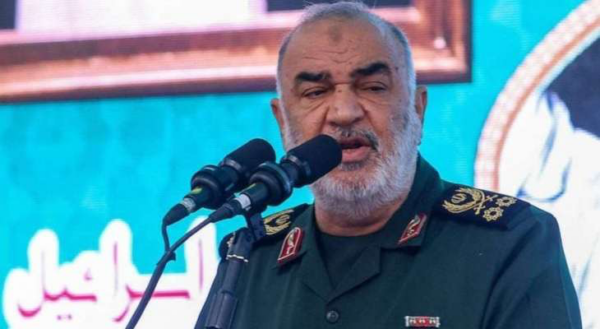The Commander-in-Chief of the Islamic Revolutionary Guard Corps (IRGC), Major General Hossein Salami claimed that Hezbollah imposed its will on Israel and that Israeli is in a state of weakness and the resistance front is at the peak of its strength today
By : Ya Libnan Editorial Board
For decades, Iran has carefully crafted a narrative portraying itself as the champion of Islam, the steadfast defender of the oppressed, and the unyielding supporter of Palestine. Through its proxies, such as Hezbollah in Lebanon, Hamas in Gaza, and its interventions in Syria, Yemen, and Iraq, Iran has claimed to lead the “Axis of Resistance” against imperialism and Zionism. However, the reality behind this narrative tells a different story—one of exploitation, self-interest, and destabilization, all for the sake of expanding Iranian influence in the region.
Iran’s Priorities: Power, Not Principles
Iran’s actions over the years have made one thing clear: Tehran’s primary concern is not the well-being of Muslims or the liberation of Palestine but the preservation and expansion of its own influence. The so-called “Axis of Resistance” is nothing more than a smokescreen for a larger geopolitical strategy that sacrifices the interests of its proxies and the countries it claims to support.
- Palestine: Despite its rhetoric about supporting the Palestinian cause, Iran has used groups like Hamas as tools to further its agenda. The recent disastrous confrontations have highlighted Iran’s unwillingness to back its words with action. Palestinians have suffered immeasurably while Iran has remained on the sidelines, issuing hollow statements and offering no meaningful support when it truly mattered.
- Lebanon: In Lebanon, Iran’s backing of Hezbollah has turned the country into a hostage of its proxy. Hezbollah’s focus on Iran’s agenda has come at the expense of Lebanon’s sovereignty, stability, and economic prosperity. The Lebanese people, particularly the Shiite community, have borne the brunt of Hezbollah’s entanglement in Iran’s regional ambitions.
- Syria: With the fall of the Assad regime, Iran has suffered a major blow to its influence in the region. Its heavy investment in propping up Assad’s rule has yielded nothing but devastation for Syria and its people. The collapse of the Assad regime marks the end of a key pillar in Iran’s “Axis of Resistance” and exposes Tehran’s inability to sustain its proxy-led ambitions.
- Yemen and Iraq: Iran’s involvement in Yemen and Iraq has similarly been marked by manipulation and destabilization. In Yemen, Iranian support for the Houthis has exacerbated one of the world’s worst humanitarian crises. In Iraq, Tehran’s interference has deepened sectarian divisions and undermined the country’s sovereignty.
The Weakness of the Axis of Resistance
The cracks in Iran’s “Axis of Resistance” are becoming increasingly evident. The so-called resistance is not a unified front but a fragmented network of proxies, each suffering from overreach, fatigue, and growing discontent among their respective populations.
- Hezbollah’s Decline: Once seen as a formidable force, Hezbollah has lost much of its credibility among Lebanese and Arabs at large. Its entanglement in Syria and blind allegiance to Iran have alienated many Lebanese citizens, who now see Hezbollah as an obstacle to peace and progress.
- Hamas’ Isolation: Iran’s relationship with Hamas has always been transactional. When Hamas’s actions lead to devastating consequences for Gaza, Iran’s support dwindles to mere words. Palestinians are left to rebuild their lives while Iran distances itself from the fallout.
- Syria’s Collapse: The fall of the Assad regime has dealt a severe blow to Iran’s regional strategy. Syria was a critical linchpin for Iran’s influence, providing a direct corridor to Hezbollah in Lebanon. With Assad gone, Iran’s ability to project power in the Levant has been significantly curtailed.
Iran’s True Face: Destabilizer, Not Defender
Iran’s rhetoric about defending Islam and standing against global powers falls apart under scrutiny. Tehran has not defended Islam but has instead weaponized it for political gain. It has not cared for Palestine but has exploited it as a tool in its anti-Israel propaganda. It has not stood with Lebanon, Syria, Yemen, or Iraq but has destabilized these countries to cement its own power.
The millions of Muslims displaced, killed, or impoverished because of Iran’s actions are a stark testament to its self-serving agenda. The Arab world and the international community must confront this reality and reject Iran’s manipulation of the region under the guise of resistance.
Time for a New Vision
The path forward must involve rejecting Iran’s divisive policies and embracing unity, sovereignty, and stability. Countries in the region must prioritize the well-being of their people over sectarian and geopolitical conflicts. It is time to expose Iran’s weakness and hold it accountable for the destruction it has wrought. Only by breaking free from Iran’s influence can the region move toward peace and prosperity.
The “Axis of Resistance” has been exposed as a facade. The real resistance lies in empowering nations to reclaim their sovereignty, rebuild their institutions, and protect their citizens from exploitation by foreign powers, including Iran. The era of Iran’s destabilizing influence must come to an end.
